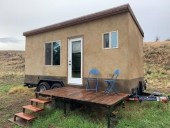posted 9 years ago
I am curious what solutions people have come up with for shear bracing of stud framed, light straw-clay walls (or clay-straw, or slip-straw, or....). I am designing a 12" thick, double stud wall filled with straw-clay. It will be plastered on both sides, so there is obviously no sheathing of any kind.
-One option is 1x3 or 1x4 let-in braces. I would want these inside the wall, so there isn't so much wood surface to plaster over. So either on the outside of the inner studs, or the inside of the outer studs, if that makes sense. In that case, I think I could even skip the "let-in" part and just nail them to the edges of the studs, since they aren't protruding past the wall plane. Unless letting them in somehow adds structural strength, but I doubt any carpenters cut their notches tight enough for that to be a factor. These braces would also serve to hold the straw clay in place, serving the function of the horizontal bamboo or dowels people frequently add.
-An easy option would be metal T braces, which are pretty harmless, but all in all I'm trying to avoid as many mass produced materials as possible. In the end, though, this wouldn't be a huge compromise to make.
-One thing I am curious about is how much shear strength is added from an inch of plaster on both sides of the wall. I have heard it said that much of the compressive strength in load-bearing straw bale construction actually comes from the plaster skin. I feel like I wouldn't trust the plaster's shear strength to resist a shock load, but just for wind loads I think it's conceivable that it would do a pretty good job of stiffening a wall. Does anyone have any insight into this? Any other shear solutions?
The other question is what to do in the south wall that is full of windows. Not much room for full length braces. Do I just sacrifice some window space to make sure the wall is sound? Or just brace the hell out of the space around the windows?






